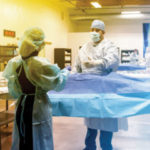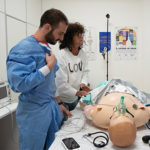Convene reached out to more than 30 high-level medical meeting professionals across a broad swath of medical practice areas to learn how the Patient Protection and Affordable Care Act (PPACA) — aka the Affordable Care Act, aka Obamacare — is changing the way they’re planning their medical meetings, conferences, and conventions, only a handful responded. The director of convention operations for a major medical society whose annual meeting draws tens of thousands of physician attendees said she was “uncomfortable” addressing the topic at this time. The ramifications of the PPACA for her convention were being discussed at the board level, she said, but not yet at the committee or staff level.
While parts of Obamacare have already been implemented, most of the major provisions — aimed at decreasing the number of uninsured Americans, lowering the overall costs of health care, improving health-care outcomes, and streamlining the delivery of health care — will be phased in by January 2014, with the remaining provisions enacted by 2020.
Change is clearly at hand. What’s behind the seeming lack of responsiveness from medical meeting professionals? In a word, uncertainty. And they’re hardly the only ones in the health-care community who are unsure how the Affordable Care Act will play out.
At the end of last year, The Physicians Foundation — a nonprofit organization whose mission is “to advance the work of practicing physicians and help facilitate the delivery of health care to patients” — released its 2013 Watch List, which identified the top five issues affecting physicians and patients this year. All five had to do with the Affordable Care Act, with “Ongoing uncertainty over PPACA” topping the list. “Much of the law has yet to be fully defined,” according to a news release from The Physicians Foundation, “and a number of key areas within PPACA — including accountable care organizations (ACOs), healthinsurance exchanges, Medicare physician fee schedule, and the independent payment advisory board — remain nebulous. The Foundation’s 2012 Biennial Physician Survey found that uncertainty surrounding health reform was among the key factors contributing to 77 percent of physicians being pessimistic about the future of medicine. In 2013, physicians will need to closely monitor developments around the implementation of these critical provisions, to understand how they will directly affect their patients and ability to practice medicine.”

‘We have an issue with capacity in primary care in particular, and the Affordable Care Act is going to aggravate that by letting more patients have access. So a lot of it is about building new models of care, new skills for managing populations, instead of kind of a traditional form of practice.’ -James P. Scott
Lou Goodman, Ph.D., president of The Physicians Foundation and CEO of the Texas Medical Association, called 2013 “a watershed year for the U.S. health-care system.” It’s “clear that lawmakers need to work closely with physicians to ensure that we are well prepared to meet the demands of 30 million new patients in the health-care system,” Goodman said in a press release, “and to effectively address the impending doctor shortage and growing patient-access crisis.”
Parsing the Crisis
The field of medicine is complex and specialized, so the extent to which the PPACA will affect a medical association’s constituents depends on its particular area of health care. But the general consensus is that family physicians are likely to bear the brunt of changes. “Family physicians are the backbone of our nation’s primary-care infrastructure, which has unfortunately been crumbling under the weight of a misaligned, inefficient, fractured health-care delivery system for many years,” said Ray Saputelli, CAE, executive vice president of the New Jersey Academy of Family Physicians (NJAFP). “The pressures faced by family physicians extend well beyond the PPACA and have existed for years before Congress enacted the law, and while some of those pressures may be relieved, some may be exacerbated. Part of the problem is that much of what is to come is still not clear to everyone.”
One of the pillars of the National Physicians Alliance (NPA), founded in 2005 for physicians across medical specialties, is ensuring “equitable, affordable, high-quality health care for all people” — so it’s not surprising that NPA is “very supportive” of the Affordable Care Act, according to NPA President Elect James P. Scott, M.D. “I think there are concerns in some areas about the additional [patient] load,” Scott said. “That may be kind of a temporary adjustment, I think. We have an issue with capacity in primary care in particular, and the Affordable Care Act is going to aggravate that by basically letting more patients have access. So a lot of it is about building new models of care, and new teams, new skills for managing populations, instead of kind of a traditional form of practice.”
Scott is referring to two outcomes of the PPACA that are abundantly clear: increased patient loads, including a high representation of minority patients who have not previously had access to medical care; and incentives to create ACOs that coordinate their services to design a more efficient delivery of health care to patients. Many factors, including health-care insurance challenges, had already started a trend of private-practice physicians joining larger medical groups and/or becoming hospital employees prior to Obamacare.
What are the opportunities for medical meetings to help transition their members and attendees to this new model of practice — and how might the meetings themselves change to better meet their participants’ new challenges?
Part of the Program
“The [PPACA] is hugely affecting our members,” said Kirsten Olean, CMP, CAE, director of meetings for the Association of American Medical Colleges. “We actually think that the uptick in attendance at our annual in the fall [of 2012] might have been in part because our members are really looking to us to guide them through all these changes ahead” — although, she added, “that is a theory.”
At its conferences last year, the American Osteopathic Association (AOA), which represents more than 100,000 osteopathic physicians (DOs) and osteopathic medical students, offered a few educational sessions about the PPACA, “which were great successes,” said Deidre Irwin Ross, MHA, CMP, CAE, AOA’s director of meetings and administration. This year, AOA is providing “additional sessions related to practice transformation and PPACA implementation, which will be eligible for category 1-A CME credit,” Ross said. “We are also offering dually accredited CME that can be used for both AOA and credit from the Accreditation Council for Continuing Medical Education (ACCME), which we see as added value for attendees.”
Added value is something that health-care professionals across every discipline are looking for. “The most important role that the NJAFP plays in our members’ professional lives with regard to the PPACA is to serve as both a conduit for information and a resource for education,” Saputelli said. “The PPACA will present different challenges to different segments of our membership. Physicians practicing in larger group practices, integrated delivery systems, hospital-owned practices, and other similar settings will require an entirely different set of services than those family physicians in smaller, independent practices, but our responsibility as their advocate doesn’t change.
“While we work to assist our members in understanding what the PPACA means to them and their patients,” Saputelli said, “we still fight the pre-PPACA battle of moving from a procedural-based system to one that is more value-based. We are continually retooling and refocusing our efforts to provide service as a clearinghouse for information and as a trusted resource for education — and that education must meet the ever-increasing burden of time faced by our members.”
With the move from private to group practice already under way, American Medical Group Association (AMGA) Director of Education and Meetings Andi Eberly said that her association is “positioned perfectly to address the vast majority of the concerns” of its members. AMGA’s 2013 Annual Conference, which took place last month, featured “content directly relevant to the changes taking place in health care, as our conference speakers are the frontline physicians and leadership of the major multispecialty medical groups,” Eberly said. AMGA attendees are “speaking to each other about what they’re experiencing first-hand and learning from each other on how to handle the flow of changes coming at them due to the Affordable Care Act. Our format is on point for what they need currently. Our attendance continues to climb.”

‘This year, we are offering additional sessions related to practice transformation and PPACA implementation, which will be eligible for 1-A CME credit. We are also offering dually accredited CME, which we see as added value for attendees.’ -Deirdre Irwin Ross
The U.S. & Canadian Academy of Pathology (USCAP), on the other hand, hasn’t yet found it critical to educate its members about the possible impact of the PPACA. “We’ve had nominal conversations, very nominal conversations,” about offering programming that deals directly with the Affordable Care Act, said Kerry Crockett, CAE, CMP, USCAP’s executive director. “Typically, the education that we put forth is really more about the diagnosis of biopsy, etc. Our members don’t necessarily have direct patient contact. For us, it does not seem to be as big [a concern] as for some of our colleagues who are in different medical societies.
“A lot of our educational content comes from outside faculty — it is driven from the community, so to speak,” Crockett said. “We haven’t really seen any discussion about [the PPACA] in terms of ‘I think we need to start educating about it.’ Internally, we are having some of those conversations about when it hits, are we going to be ready and are we going to be able to meet the needs of our members? We are really looking to our pathologists that are on our education committee to guide us in terms of what programming is going to be.”
How CME Will Change
One thing seems certain: the nature of CME education will have to evolve as a result of the PPACA. “From a CME perspective, a piece of it is the education around what are the evidence-based best practices for population management for caring for patients in teams and so on,” NPA’s Scott said. “Which is a little different than what we see in CME, which is what’s the contemporary management of diabetes, or something like that. If you think about it, there’s evidence-based medicine and then there’s evidence-based delivery of care. I’d say from a subject-matter perspective, it may be a bit of a change” in terms of the programming that’s offered at conferences.
The ACO model is “basically about getting together with a group of providers to provide cost-effective, high-value care,” Scott said. As the number of ACOs grows, that “may influence the revenue stream of some high-end specialties. So I’d say those are the ones who are the most concerned — you know, radiology, orthopedics, some of those kind of specialties; cardiology has already seen a pretty big hit. And some of them are going to be thinking about CME. They may be a little tighter with their budgets because they’re going to start seeing their income shrinking, potentially.
“They’re going to need to learn how to kind of cope with the changes that are coming, which are potentially not so much in their favor,” Scott said. “And so from a CME perspective, again, gearing up with learning how to kind of manage your way through the change and if there are changes you need to make, the way you’re going to need to collaborate with people — and how much credit you’re going to be able to get for that kind of stuff.”
As physicians join hospitals, academic institutions, and other practice groups, Scott said, they probably get a CME allowance, as opposed to having to pay for conferences and CME out of their own pocket. “So from that perspective, I’d say that’s probably good news [for medical meetings,] because [for] doctors [it will be] use or lose it,” he said. However, physicians employed by larger entities — group hospitals or group practices — are likely to have less of a choice about what conferences they would like to attend, Scott said, and probably will be “pushed into conferences that the organization deems are going to help move a larger agenda along.
“That’s the other big thing that I think your industry should be thinking about,” Scott continued. “That group may have an agenda — like, ‘these are the six things we’re trying to improve this year.’ Then they’re going to want to have directed CME focused on educating their doctors and getting them on board with these particular improvement efforts. There’s a need for CME — like, this is the latest new development in rheumatology or cardiology or whatever it is — and then there’s, how do I actually bring that back to my institution and get it implemented in less than a decade? And that’s the disconnect we’ve had for a long time, in my view, with CME.”
No Time at All
Not only will lack of choice become an issue as the Affordable Care Act unfolds, but so will increased time constraints, according to Kathleen Flood, CEO of the American Society of Nuclear Cardiology (ASNC). “As physicians merge into larger groups and/or become hospital employees, their ability to attend conferences will be challenged since they will have a discrete number of days for these activities,” she said. “It is my opinion that this trend will continue to grow. The more senior physicians now that have led the negotiations have some leverage, but this will wane over time with the younger physicians. We are planning a deep dive into our annual meeting to understand how it must change in both content and format. We need to be more strategic about developing easily accessible and very relevant CME offerings that bring education to the point of service.”
Likewise, AOA “understands that being out of the office for a stretch of several days can be difficult,” Ross said. “DOs working in an independent practice may worry about who will cover their patients and that time out of the office is time that could be spent on new administrative duties like quality reporting. If a DO works for a hospital or a large medical center, they might have to convince their bosses to give them the time off.”
One way that AOA is addressing that concern is by starting OMED, its annual Osteopathic Medical Conference & Exhibition, on a Saturday instead of a Sunday, beginning next year — “thus requiring attendees to take one less weekday out of the office,” Ross said. AOA is also “trying to make it easier for DOs to earn CME credit, while being mindful of their time restrictions,” by offering additional regional conferences. “Two or three times a year, DOs are given the opportunity to earn up to 24 category 1-A CME credits at these smaller-scale conferences,” she said, which are held over weekends “to limit out-of-office time.”
The Exhibitor Piece
While Eberly said the exhibit hall at AMGA’s 2013 Annual Conference “sold out early with a long wait list,” other medical associations — having already made significant changes to the way their meetings and education are funded — continue to reassess their exhibitor component in light of the PPACA. Under the AOA’s Standards for Commercial Support, for example, the organization no longer offers CME credit to attendees who visit exhibitor booths during the meeting. “This could become more common after the recent implementation of the ‘Sunshine Rule’ of the ACA,” Ross said, “which calls for transparency in the relationships between manufacturers of drugs, devices, biologicals, and medical supplies and physicians.”
Scott thinks that the “consciousness” around transparency and conflict of interest is only going to keep “increasing, and so people are going to have to keep looking for different sources of revenue to support their CME activity,” he said. “Some of the specialties are so tied with pharma, like psychiatry, and certainly orthopedics with the device manufacturers — it’s going to be an interesting transition.”
At ASNC, Flood said, it’s time “to rethink how to connect vendors and our members.” One “final piece” of the PPACA that will directly affect her members — and therefore exhibitor participation at her events — “is the continuous cuts to reimbursement,” she said. “This is making it more difficult for practices to reinvest in new technology that is often safer and more effective than older products.”
Meanwhile, AOA has retooled OMED’s trade-show floor “to offer more product-theater programs,” Ross said, “which are organized presentations from industry leaders on the latest news and research in topics like diabetes, pain, and sleep issues.”
While there is no CME credit granted for attending product theaters, “attendees are able to enjoy an additional educational experience,” she said, that “enriches” their overall conference experience.

‘We have a hybrid component now with our Annual Meeting where we record sessions and sync them to PowerPoint. But the goal is to really, truly do a hybrid event where folks can actually feel like they are part of that session.’ -Kerry Crockett
Virtual Medicine
Given the challenges that many health-care providers may have in leaving their office to attend a face-to-face conference, medical associations like AOA are also “exploring options for offering online sessions that run concurrently with live sessions” that take place at OMED, Ross said.
AOA has not yet started to offer these online sessions at its meeting, “because we want attendees to be able to receive 1-A CME credit for attending these sessions at OMED,” she said, but “we look forward to providing simultaneous webcasts in the near future.”
Going hybrid is “one of the things in the works” for USCAP’s Annual Meeting, Crockett said. “We have a component of that now with our Annual Meeting where we record sessions and sync them to PowerPoint,” she said, but the goal is to “really, truly do a hybrid event where folks can actually feel like they are part of that session. We don’t do the type of hands-on sessions other [medical meetings may offer] — for example, different techniques in terms of surgical procedures. We are doing a hands-on event at our Annual Meeting this year, which is an ultrasound event for startup pathologists, for those that do fine-needle aspiration. We are trying to figure out how that is going to translate to a virtual audience — I think that is going to be challenging. You are not going to have that same experience as you would live. The didactic lectures are the ones we are certainly thinking would be beneficial to stream live and then give [the virtual audience] an opportunity to ask questions to the moderator and that sort of thing. That is where we were thinking that we would find what could be of most benefit to the attendee.”
As the PPACA is gradually enacted, one thing that is clear is that medical meeting professionals need to stay attuned to their particular communities. “We are continuously asking our members what they need,” NJAFP’s Saputelli said, “to lift the cloud of uncertainty under which they have practiced for far too long.”




